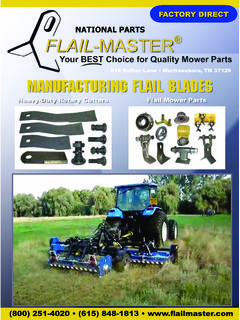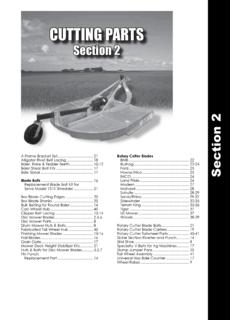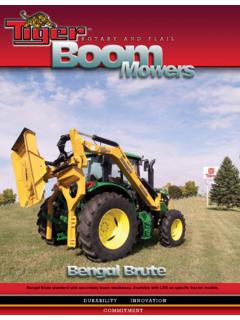Transcription of What you should know about excavator mounted grinders…
1 What you should know about excavator mounted Fixed Tooth or flail ? The decision between fixed tooth and flail type cutters should be based on power available, type and size of trees, and grinding conditions. Power Available-Fixed tooth cutters require more power than flail cutters. This is because flail type cutters use hammers that strike the wood, and then swing back. The only inertial energy that you are imparting to the wood during grinding is the energy stored in the hammer itself. Once the hammer hits the wood, the cutting edge swings back into the rotor and is then re-accelerated back to the rotor speed by centrifugal force. flail type cutters work well in low horsepower environments (small excavators) but surprisingly, do not work well in higher power applications unless the hammer weight is high and is placed away from the rotation point. This is because the amount of power that you can take from the rotor and hammers and put to the wood is directly proportional to hammer weight.
2 It has very little to do with the rotor weight. Fixed tooth cutters are much more power hungry. When a tooth of a fixed tooth grinder strikes the wood, it has the inertial energy behind it of all of the other teeth, the drum, the shaft, the sprocket, everything that is rotating on the cutter head. Subsequently, a fixed tooth grinder will cut large hard and soft wood much faster than most flails. Fixed tooth grinders need more power because once the drum starts to slow, you must re-accelerate all of the teeth, and the drum, the shaft, etc. again before you re-engage the wood (on large trees). This is a good reason to cut as much wood as you can with the energy you have stored (see Tooth Longevity and Production below) excavator Powered or Auxiliary Powered? excavator powered cutting attachments should only be chosen for light brush or small trees. Generally speaking, a 200 size excavator is the smallest size that should be chosen for fixed tooth cutters.
3 This stems from the fact that excavators as large as 300 size machines only have 200-250 HP. Grinding with excavators, unlike using jack hammer type attachments, requires constant movement in order to feed material into the cutter head. If you are not moving, you are not grinding wood. As you feed large material into the cutter head, it will slow. If you want to get the cutter head speed back up, you will need to move the head. Production with ANY grinding system is directly linked to horsepower. Horsepower is what keeps the cutter head going, and horsepower is what re-accelerates the head so you can grind again. The more horsepower that you have, you more wood you can process in a given time. Auxiliary power systems are used for high production grinding. Two Hydraulic Motors vs. One Two motors are better than one . This is probably one of the biggest myths being spread today about attachments, (usually by sales people who don t know any better).
4 The fact of the matter is that one large hydraulic motor will produce exactly the same torque and horsepower as two small motors half the size. This is because torque is a function of displacement and pressure. Torque Output=Pressure (PSI) X Displacement (cubic inches per revolution) 2 X (1) 14 cubic inch motor being driven by 5000 PSI would 5000 X 14 2 X = 11,146 inch pounds of torque (2) 7 cubic inch motors being driven by 5000 PSI would produce the exact same torque Motor 1 5000 X 7 2 X = 5,573 inch pounds of torque Motor 2 5000 X 7 2 X = 5,573 inch pounds of torque 5,573 + 5,573 = 11,146 total inch pounds of torque Horsepower output of a motor=Torque Output (inch pounds) X RPM 63025 With the same flow to the motor(s)
5 , the rpm would be the same for our large 14 cubic inch motor as the smaller 7 cubic inch motors (total displacement is the same). Therefore, the horsepower output would be exactly the same. Two motors also presents a unique situation when driving a common shaft. If one belt breaks, the oil will flow to the area of least resistance. This would be the motor no longer connected to the cutter by the belt. At this instance, since all of the flow is going through this motor, it s speed goes to 2X normal. If the motor is not rated for this speed, damage can occur quickly. Tooth Longevity and vs. Steel If you think about it, teeth are the connection point of the power that you are paying good money to produce, and the wood that you are trying to make into little pieces. The more efficiently the teeth cut, the more wood you can process with a given amount of power. Blunt or dull teeth will create drag which will cause the drum to slow quickly, causing the need to slow down cutting rate in order to recover.
6 They also create a re-acceleration event more deeply and often. Thick carbide teeth will last longer than tool steel but productivity during cutting with dull, wide teeth will hurt your production over a longer period of time. Imagine, even from the beginning, the difference in hydraulic pressure and inertia required to push a tooth that is 1 wide through the wood, as compared to pushing a very sharp edge through the wood. As large, wide carbide teeth begin to loose the critical cutting edge, they become little more than hammers, trying to tear the wood or break the wood rather than cutting it. Cutting is much more efficient than bludgeoning wood. (This is the reason you take an ax to cut wood rather than a hammer). Shinn Systems cutter heads feature teeth that can be rotated four times during their life. Rotating teeth takes only 10 minutes, and afterwards you are cutting at nearly 100% efficiency.
7 Tooth Cost (myth vs. reality) Cost of steel teeth vs. Tooth Cost $ $ Tooth Life 280 hrs. 400 hrs. Cost per hour/per tooth .065/hr .0875/hr. You can see from the information above, it is actually less expensive to run steel teeth than carbide teeth. If you consider that tool steel teeth are much more effective in cutting wood than carbide teeth, you are also cutting more effectively over the life of the teeth. Cutter Head Line or 90 degrees In line mounts (cutter heads mounted in line with the stick and boom of the excavator ) should only be used on excavator powered cutter heads and in very small trees or brush. Here s excavator working arms (the boom and the stick), are basically built like your knee. They are designed to push or pull in line with the arms themselves. Excavators, built primarily to dig, have tremendous power in line with the arms. However, if you examine the pins and bushings of an excavator , you will quickly realize that the connect points of the arms are very narrow (less than 14 for a 300 size excavator at the bucket connect point).
8 excavator bucket linkages are deceiving because they carry little or no side load. Most all of the side load on the end of the stick of an excavator goes to one pin and two bushings at the end of the stick. This means that any side loading of the stick is transmitted through stick and boom across a very narrow area. Consider that this force is applied as an up force on one side of the 14 connection, and a down force on the other side of the connection. You effectively have less than 7 of pin and bushing holding of the force in a direction 180 degrees from the other side of the pin and bushing. Excavators working arms have another disadvantage regarding side load. This is leverage. Because reach is an important and useful feature of an excavator , the arms (stick and boom) are very long. Consequently, any force applied at the end of the stick, has tremendous leverage over the pins and bushings, and the swing gear of the excavator .
9 You can prove this by going to your excavator , extending the arm of the excavator and then pushing on the side of the stick. You can literally rotate 30,000 lbs. of upper car body, engine, cab, counterweight, and arms using one hand. Now imagine a fixed tooth cutter head working on the end of the excavator with a rotating mass of 1200 lbs. If it is mounted with the drum 90 degrees to the stick (drum shaft is parallel with the stick pin, and it hits a stump and suddenly stops, the force is transmitted straight down the stick in the direction it is most strong. Now image the same drum mounted in line with the stick. The reaction of the drum, as it stops, is opposite of the direction of rotation. In this case, this reaction is 90 degrees to the stick. Instantly you release the energy of everything that is rotating in the cutter head, plus the torque being supplied by the hydraulic motor, as a side load through the stick, through the boom, through the car body, and into the swing gear.)
10 As the horsepower increases, the torque, and therefore the side load increases. Now imagine doing this all day, day in and day out. Pins, bushings, stick and boom welds, and swing gear will eventually suffer the consequences. Safety During Operations Systems has NEVER experienced an injury of an operator due to flying debris. The cutter head rotates away from the operator and because the angle of the shield can be changed during grinding it is also safer for others nearby. Additionally, we install Lexan windscreens with NASCAR type tear offs in the cab. We also provide a FOPS cage and front grating for the machine to protect against falling trees. Systems grinders are used in day to day operations on some of the busiest interstate highways in the country. Operations on the side of the road, in residential areas, near power lines are not uncommon. Debris control is a hallmark of the design of this system.








